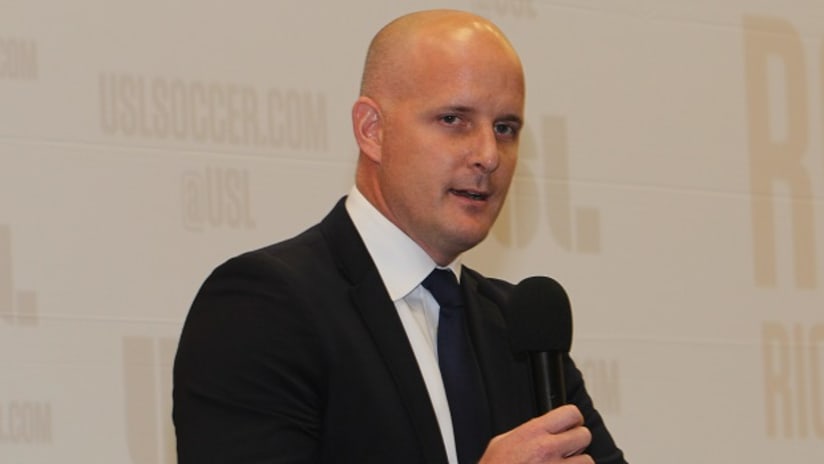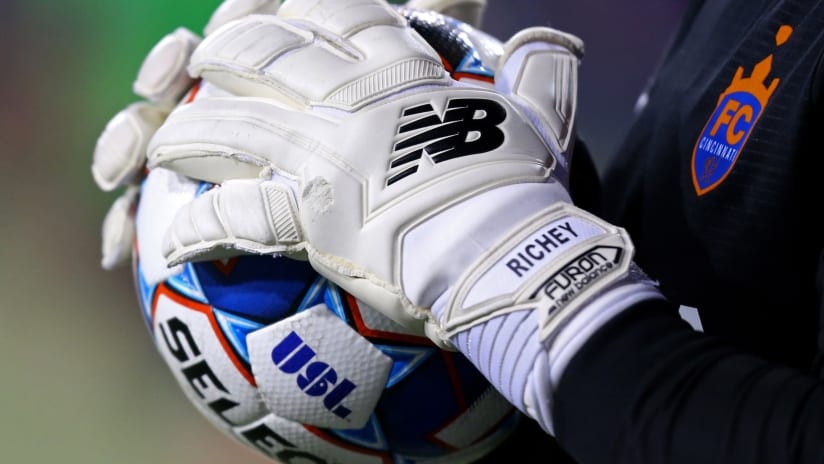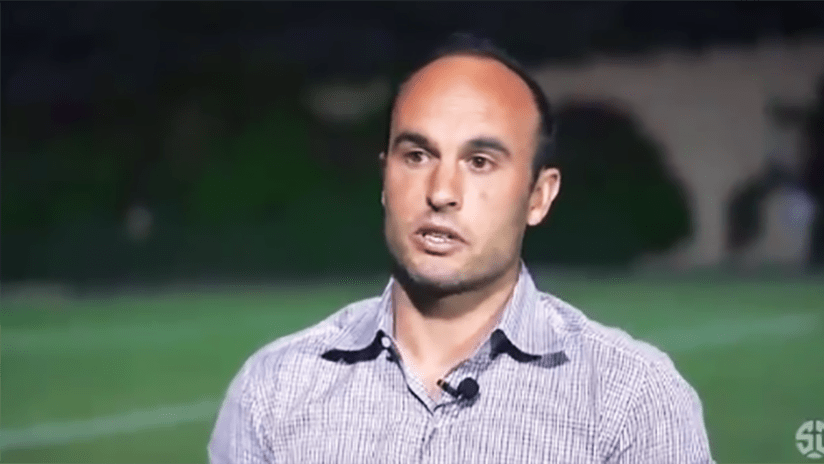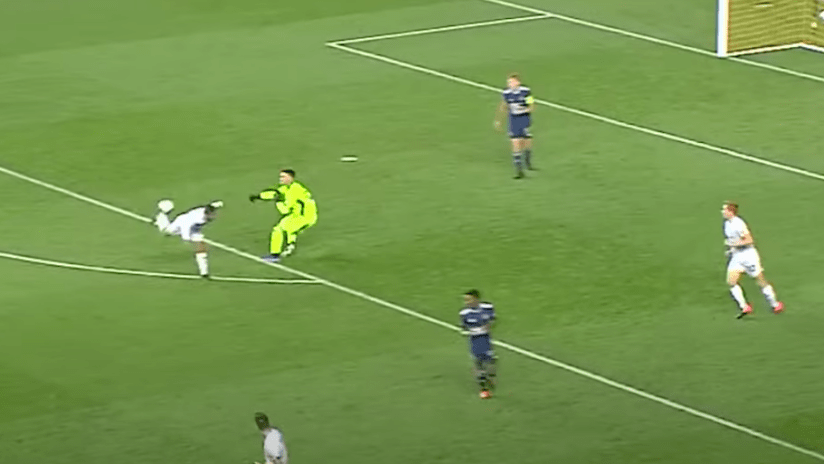For the first time in the history of the league, the USL Cup final will be contested between two teams owned by MLS clubs, with New York Red Bulls II set to host Sporting KC’s Swope Park Rangers on Sunday night at Red Bull Arena (8 p.m. ET, ESPNU).
The occasion will be a milestone in the partnership between USL and MLS, which has seen 11 MLS clubs start their own USL teams since the start of 2014 and a 12th, Houston, partner with an independent USL club, Rio Grande Valley FC, to run their soccer operations.
Another MLS team, the San Jose Earthquakes, will enter a similar agreement next year with USL expansion club Reno 1868 FC, with the Quakes set to lead all aspects of soccer operations while Reno, who are owned by Herb Simon, the owner of the NBA’s Indiana Pacers, oversees the business side.
According to USL president Jake Edwards (pictured above), we could very well see more MLS teams shift toward the Houston and San Jose USL model in the future.
USL experienced a good deal of growth in 2016, with five new clubs entering the league and two more – Reno (starting 2017) and Nashville (starting 2018) – announced as expansion sides.
Attendance was excellent for many of the independently owned clubs, with FC Cincinnati averaging an astonishing 17,296 fans per game in their inaugural season, Sacramento Republic FC selling out 14 of their 15 home matches and drawing 11,514 fans per match and two other clubs, Louisville City FC and San Antonio FC, averaging 7,218 and 6,170 fans per game, respectively.
“I would say the top 10 teams now in our league have been pushing 7,000 (attendees per game),” Edwards said in a phone interview with MLSsoccer.com on Wednesday. “We’ve seen sellouts across the league this year in many markets…. We’ve seen a real appetite for soccer in the local markets and a real sort of tribal following now beginning to emerge for those clubs. They’re making a lot of investment into the game and into engaging with the fan base. And ultimately, the quality on the field is very good and very entertaining and people are having a good experience when they go to these games, so we’re very pleased about where the attendance is trending.”
The league is also investing heavily in their broadcast operations this winter. They’re opening a centralized production center in South Florida with broadcast company Vista Worldlink, from where they’ll produce all USL broadcasts in 2018. The facility will eliminate the need for teams to have on-site production crews and satellite trucks, an expense that can run up very quickly for lower-budget clubs.
The league is also currently negotiating a new deal with ESPN, which broadcast 20 USL matches on their streaming network, ESPN3, this year and will air Sunday’s final on ESPNU.
While the broadcast operations are being bolstered and attendance was inarguably impressive for many of the league’s independent clubs, the MLS-owned teams mostly lagged behind. None of the 11 teams owned by MLS clubs averaged more than 3,000 fans per match in 2016, with three drawing fewer than 1,000 fans per game. The highest-drawing MLS-owned teams, Philadelphia’s Bethlehem Steel FC and Salt Lake’s Real Monarchs SLC, clocked in at 12th and 13th in the league with an average of roughly 2,500 fans per match.
Edwards noted that MLS clubs face built-in challenges for selling tickets that independently owned USL clubs don’t have to worry about. Unlike the independent teams, MLS clubs selling USL tickets are selling a second team. If the first team isn't selling out MLS games, clubs may be hesitant to commit scarce resources to selling USL tickets for their farm team's games. Also, they’re selling in markets that already have established professional teams playing at a higher level – and asking fans to shell out more money to attend around 15 additional matches per year on top of the 20 games most clubs include in their MLS season ticket packages can be a big ask.
Edwards noted that, despite the low numbers, many MLS-owned USL teams saw attendance rise this year. Still, he said those business-side difficulties may prompt some MLS teams to shift from owning their own USL clubs to following the Houston and San Jose model of affiliating with a nearby independent team to run their soccer operations while local ownership manages the business.
Those types of changes could happen as soon as the 2018 season.
“We continue to work with them to find the right solutions to sort of turn to both of those questions and some of them will carry on and keep investing and see the results and some of them will look at perhaps some alternative affiliation models and see if that makes more sense,” he said. “So it’ll evolve. It’ll evolve slightly for some of those teams over the coming seasons, I believe. We’ll find the right solution that makes sense for some of them if they’re not achieving their goals already.”
The good news for MLS teams potentially considering a shift in their USL model is they’ll have plenty of solid affiliate options to choose from. Edwards said USL is planning on continuing to expand for at least a few more years with an eye on eventually forming three conferences – Eastern, Central and Western – of 12-15 teams each.
Reno and Nashville have both been confirmed to join the league in the next two years, and it’s also been reported recently that the NASL’s Tampa Bay Rowdies and Ottawa Fury will move to USL next year. Edwards declined to comment on those reports, saying the league would address them after the season.
There’s also the possibility that the Austin Aztex, who have been on hiatus since midway through the 2015 season after flooding damaged their stadium, will eventually return. Edwards said that the club wouldn’t be back in 2017, but that the league and local ownership are working to get a stadium built in Austin to secure a return to USL.
“Expansion will continue for certainly for a few more seasons,” Edwards said. “There are a couple more strategic markets that we think will do tremendously well, will sustain a really solid club and a good fan base. We’ll continue to do that as long as we’re working with the right people and have the right ownership behind it.”













